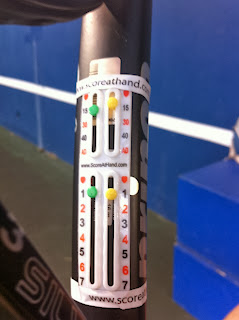Playing tennis just for fun is a great way to spend your free time. Most of the time you play outdoors, and
getting great exercise; but how about spicing up your tennis game with a little bit of competition? You can always challenge your tennis opponent for a set or two of real tennis and add a little bit of fun by making the winner
pay drinks or lunch at the end of the match.
Score At Hand can easily help you keep track of your score while playing tennis and having fun at
the same time! It’s like being the referee of your own game. As a refresher, the basics of score keeping in tennis are outlined for you below.
After warming up on the court, the server is normally decided by spinning the racket by one player and the
other player calling “up” or “down” and the racket logo on the end of the racket determines who wins. One player spins, while the other player calls. The player who wins the spin can decide to be the first server
or take a certain side of the court (handy when the sun or wind plays a factor).
A normal tennis match is usually composed of either three sets (for women players) or five sets (for male
players) while each set is won by the player or team who first reaches six games (must be won by 2 games), unless both reach 6, and then a tiebreak is played. To win a set tiebreak, players must be the first to reach 7 points
(win by 2 points).
Once play starts, Score At Hand can really help your game. First of all it’s great to have your score right on the
racket. Once the point is over, you can quickly move the peg and prepare for the next point. Scoring in tennis is a little odd, there’s a great story about tennis scoring in the New York Times that you can see here.
 |
| Score At Hand on a Tennis Racket |
The best way to be sure you and your opponent are on the same page is to call the score out before each point
is played. Although there are 4 points, you must win by 2, and they are called 15, 30, 40 and game. If you should both get to “40 all” or “Deuce” then there is an “AD” or advantage. The game can be quite lengthy
as you can play “ad” and Deuce” points back and forth until the player with the “AD” or “advantage” gets another point (winning by 2 points).
Let’s say that you start the first set by serving and your opponent fails to return the ball. You win the
point and when you serve next (on the other side of the court), you should announce the score as “15-love*”. Then you can move the green or yellow button (depending on which color you have chosen for yourself) on the
upper part of Score At Hand to 15 while leaving that of your opponent’s yellow button at 0 Also known as “LOVE”.
Enough talking! Now grab your friend and your racket and head over to the tennis court. It’s time for some
real tennis with your scorekeeper Score At Hand!
*(Fun fact: “Love” in tennis stands for zero. The legend has it that the word derived from the French
word for an egg “l’oeuf”, since an egg resembles zero. And when the English speaking world heard of the word, they mistook l’oeuf for love.)
# # # # # # # # # # # # # # # # # # # # # # # # # # #
Always know the score with Score At Hand!
# # # # # # # # # # # # # # # # # # # # # # # # # # #
Always know the score with Score At Hand!
# # # # # # # # # # # # # # # # # # # # # # # # # # #

No comments:
Post a Comment